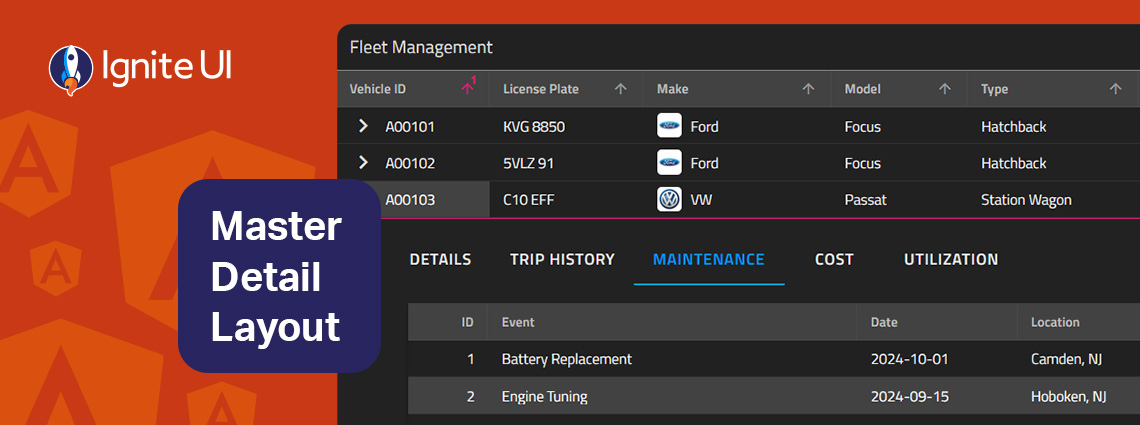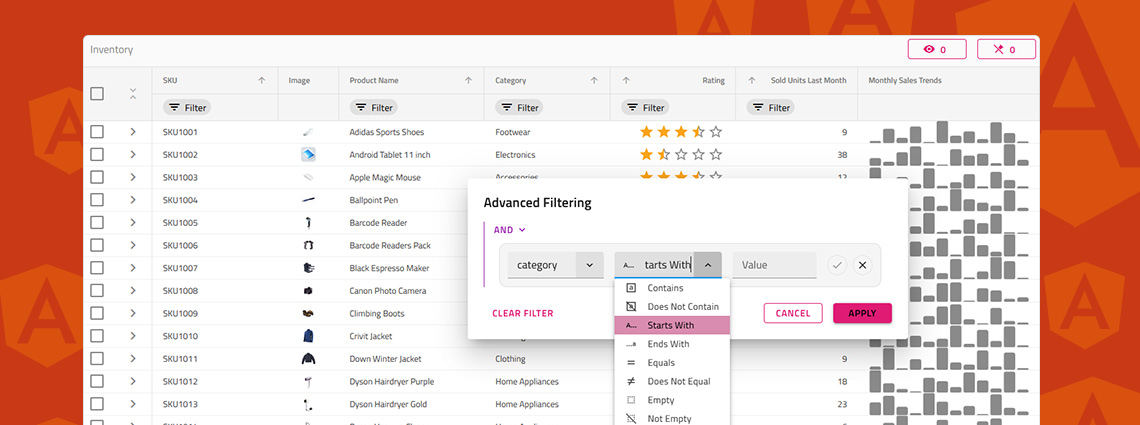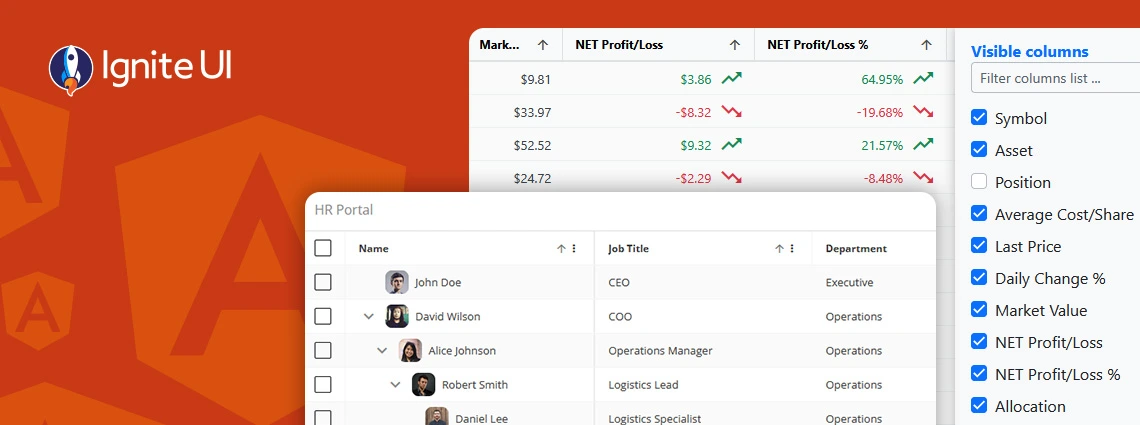
Blazor vs Angular: A Comprehensive Comparison
O que você deve escolher entre Blazor e Angular? Descubra o estado do Blazor hoje e como ele se compara a um dos frameworks mais populares, Angular.
Até recentemente, se você fosse um desenvolvedor C# e quisesse escrever código para navegadores, você praticamente usava JavaScript. Mas o mundo do desenvolvimento web está mudando rapidamente e você não precisa mais depender do JavaScript para o desenvolvimento de aplicativos da web de ponta.
E se eu lhe dissesse, então, que você poderia usar Blazor para o desenvolvimento de aplicativos do lado do servidor e do lado do cliente? Nesta postagem do blog, explorarei o que isso realmente significa comparando Blazor com Angular, ambas as principais opções para desenvolvedores modernos.
Principais conclusões do artigo:
- Visão geral da estrutura: o Blazor utiliza C# no ecossistema .NET para aplicativos Web, enquanto Angular é uma estrutura madura que usa TypeScript principalmente para SPAs (aplicativos dinâmicos de página única).
- Modelos de hospedagem: Blazor oferece dois modelos: Blazor Server (com atualizações em tempo real via SignalR) e Blazor WebAssembly (execução do lado do cliente). Angular se concentra na renderização do lado do cliente para melhorar o desempenho e a experiência do usuário.
- Desempenho: Angular geralmente fornece tempos de carregamento iniciais mais rápidos devido à sua abordagem JavaScript otimizada, enquanto Blazor WebAssembly pode experimentar cargas mais lentas, mas oferece execução eficiente quando ativo.
- Experiência de desenvolvimento: Blazor tem uma curva de aprendizado mais suave para desenvolvedores C#, enquanto a dependência do Angular no TypeScript introduz complexidade, mas fornece recursos poderosos para a criação de aplicativos robustos.
- Casos de uso: Blazor é adequado para aplicativos que precisam de interações do lado do cliente e do lado do servidor, enquanto Angular se destaca em interfaces de grande escala e alto engajamento.
- Pontos fortes e fracos: A familiaridade do Blazor com desenvolvedores .NET e a eficiência de processamento do lado do servidor contrastam com o ecossistema estabelecido e o carregamento rápido do Angular, embora a complexidade do Angular possa desafiar os recém-chegados.
| Angular | Blazor | |
|---|---|---|
| Pronto para produção | Angular está pronto para produção hoje com anos de implantações testadas em batalha. | Com o lançamento do .NET 6 em novembro de 2021, Blazor fez grandes melhorias e pode ser considerado pronto para produção para a maioria dos aplicativos. |
| Curva de aprendizado | Maior curva de aprendizado quando comparado ao Blazor, especialmente para desenvolvedores .NET / C #. | Acesso fácil para desenvolvedores de C# e Visual Studio. |
| Performance | Mais ajustado para o desempenho, pois a estrutura é muito madura. | A Microsoft continua a ajustar Blazor desempenho, o .NET 6 abordou muitos dos problemas das versões anteriores. |
| PWA (Progressive Web App) Support | Sim | Yes (Blazor Web Assembly) |
| Requer uma conexão ativa por cliente | No | Yes (Blazor Server) |
| Armazena o estado do componente no lado do servidor para cada cliente | No | Yes (Blazor Server) |
| Estilos com escopo definido para componentes | Sim | Sim |
| Tamanho do pacote | < 50KB (Ivy com gZip) | Mínimo para Blazor Server. Tão baixo quanto 393kb, até 780kb para .NET Framework em um aplicativo WASM do lado do cliente. |
| Ferramental | CLI mais muitas opções de terceiros. | CLI, Visual Studio e 3 opções de terceiros. |
| Otimizado para SEO / Crawlers | Angular renderização do lado do servidor. | Sim |
| Cadência de envio | 2 grandes lançamentos por ano, o que é muito para as empresas acompanharem. | 1 versão principal por ano com o .NET, com pequenas atualizações ao longo do ano. |
| Estilo de código | Muito detalhado, muito clichê para começar. | Otimizado para menos clichê, fácil de começar. |
O Blazor Hype ainda é relevante?
Há alguns anos, Blazor era uma das tecnologias mais comentadas no ecossistema .NET. Ele prometia uma visão ousada: desenvolvimento web full-stack com C#, eliminando totalmente a necessidade de JavaScript. A ideia de executar código .NET diretamente no navegador usando WebAssembly gerou entusiasmo entre os desenvolvedores, especialmente aqueles que já investiram na pilha da Microsoft.
A situação é um pouco diferente agora e Stamen Stoychev, Gerente de Desenvolvimento de Produto da Infragistics, tem uma observação interessante. Segundo ele:
"Qual é a situação em 2025? Embora o burburinho inicial em torno do Blazor certamente tenha diminuído, ele ainda está aumentando seu público, embora mais lentamente e principalmente onde sempre se esperava – empresas com software complexo já no .NET que precisam de uma maneira fácil de trazer seu front-end para a web.
Sua principal desvantagem ainda é impedi-lo de um apelo mais amplo –Blazor os tempos de carregamento iniciais do WebAssembly são maiores devido à necessidade de baixar o tempo de execução do .NET no navegador. Isso contrasta com estruturas JavaScript como Angular, que normalmente são menores e podem aproveitar a renderização do lado do servidor e o carregamento lento para obter desempenho de alta velocidade."
Blazor está fazendo melhorias nessa frente, então vale a pena ficar de olho para futuras reavaliações.
O que é mais difícil de vender, porém, é que o JavaScript continua sendo de longe a linguagem de programação mais usada no mundo. Pedir aos desenvolvedores que mudem para algo totalmente diferente (com pouco ou nenhum ganho de produtividade) é uma proposta complicada para a maioria dos desenvolvedores da Web de hoje.
O que é Blazor?
Blazor é uma estrutura da Web do Microsoft ASP.NET Core que permite que os desenvolvedores escrevam código para navegadores em C#. Blazor é baseado em tecnologias da Web existentes, como HTML e CSS, mas permite que o desenvolvedor use C# e sintaxe Razor em vez de JavaScript. Razor é uma sintaxe de marcação de modelo popular para .NET. Blazor (Navegador + Razor) permite que os desenvolvedores criem interface do usuário da Web interativa e reutilizável para aplicativos do lado do cliente escritos em .NET e implementados no WebAssembly. Com código de cliente e servidor escrito em C#, ele permite que você compartilhe código e bibliotecas, fornecendo uma plataforma para permitir o desenvolvimento de aplicativos de página única (SPA) vibrantes e contemporâneos enquanto usa o .NET de ponta a ponta.
O maior destaque do Blazor é que ele aproveita os padrões da Web mais recentes e não precisa de plug-ins ou complementos adicionais para serem executados em diferentes modelos de implantação, seja uma opção WebAssembly do lado do cliente e uma opção de ASP.NET Core do lado do servidor.
Entendendo o WebAssembly
WebAssembly, muitas vezes abreviado como Wasm, é um novo padrão que pode ser executado em navegadores modernos, trazendo diversidade de linguagem para a plataforma web. Wasm é uma linguagem semelhante a assembly de baixo nível com um formato binário compacto que possibilita a execução de código escrito em várias linguagens, como C/C++, Java e Rust, na web com desempenho quase nativo.
O objetivo do WebAssembly é facilitar aplicativos de alto desempenho em páginas da web. No entanto, seu formato é projetado para execução e integração em outros ambientes e também pode ser executado junto com o JavaScript.
Características do Blazor
- Crie interfaces do usuário da Web com C# em vez de JavaScript ou TypeScript
- Criar PWAs (aplicativos Web progressivos)
- Criar e usar componentes Blazor reutilizáveis escritos em C#
- Suporte completo à depuração no lado do servidor e depuração com algumas limitações no lado do cliente
- Vinculação de dados com o HTML DOM (vinculação bidirecional limitada)
- Compartilhar código entre cliente e servidor em C#
- Server and client-side models
- Server-side rendering (aka pre-rendering) for higher performance
- Compilação antecipada
- Scoped styles
- Conexões WebSocket
- Works offline (client-side WebAssembly only)
- Funciona em todos os navegadores modernos, incluindo navegadores móveis
- Blazor code has the same security sandbox as JavaScript
- Usar a interoperabilidade JavaScript para chamar estruturas e bibliotecas JavaScript
- Open source

O que é Angular?
Angular, o sucessor do AngularJS, foi criado pelo Google para permitir que os desenvolvedores de front-end interajam com o front-end e o back-end ao mesmo tempo. Como Angular é baseado em JavaScript, há muitos recursos para trabalhar.
Angular existe há mais de uma década, enquanto Blazor está no mercado há apenas alguns anos. Angular é uma estrutura pronta para produção com suporte total para aplicativos MVC/MVVM, e muitas grandes empresas a estão usando. Blazor, embora seja usado por algumas grandes marcas, está no início de seu ciclo de vida.
Se você passar pelo Reddit, notará algumas opiniões polares, mas geralmente, posso resumir esses fatores:
- Se você for um desenvolvedor C#, Blazor é preferível para produtividade, consistência e alternância de contexto reduzida
- Para compatibilidade e comunidade mais amplas, Angular e React ainda lideram, mas vêm com mais partes móveis
- Blazor Server está mais maduro/estável, enquanto o Blazor WASM está se atualizando, mas ainda pesado
- Alguns desenvolvedores usam Blazor + React ou Blazor + JS interoperabilidade juntos, dependendo das necessidades
Angular e Blazor suportam PWAs (aplicativos da Web progressivos), embora Blazor lado do servidor não possa ser implantado como um PWA, apenas o lado do cliente Blazor baseado em WASM. Tanto o Angular quanto o Blazor são suportados nos principais IDEs, com suporte completo à depuração, bem como ferramentas adicionais para produtividade do desenvolvedor.
Angular se destaca em termos de popularidade e ecossistema:
- Quase 80 mil estrelas e 20 mil + bifurcações no GitHub
- Mais de 275.000 perguntas no Stack Overflow
- Recursos de aprendizagem abrangentes: cursos, livros, blogs e vídeos
- Eventos regulares de tecnologia focados em Angular em todo o mundo
- Forte suporte à integração de ferramentas e bibliotecas de terceiros
Angular pode carregar aplicativos mais rapidamente usando "compilação antecipada" ou AOT. O AOT converte seu código HTML e TypeScript Angular em código JavaScript eficiente durante a fase de compilação antes que o navegador baixe e execute esse código. Compilar seu aplicativo durante o processo de compilação fornece uma renderização mais rápida no navegador. Blazor também dá suporte ao AOT, mas com o WebAssembly do lado do cliente, que tem uma carga de implantação inicial maior em comparação com o .NET Framework.
Recursos adicionais de desenvolvimento Angular incluem:
- Estilos com escopo para isolar CSS para componentes específicos
- Arquitetura modular por meio de elementos e módulos Angular
- Carregamento lento para melhor desempenho
- Suporte I18n (Internacionalização) para localização
- Integração iônica para desenvolvimento móvel multiplataforma (iOS e Android)
Como mencionado brevemente, há um enorme repositório de pacotes de código aberto disponíveis para desenvolvedores Angular, incluindo:
- Ignite UI for Angular
- NgBootstrap
- Angular Google Maps
- NgRx
- NgTranslate
- AngularFire
- NgxTextEditor
- Angular Material
- Ng2 Pdf Viewer e muito mais

O estado do desenvolvimento web está sendo levado a outro nível. Os engenheiros de software não precisam mais depender das estruturas típicas e ferramentas desatualizadas para as soluções que criam. Agora eles têm a chance de transformar e simplificar a maneira como seu software ganha vida. E aqui está algo interessante.
Os últimos dois meses foram muito ocupados para nossas equipes técnicas em Infragistics pois estávamos trabalhando em maneiras de aprimorar nosso App Builder para aplicativos Angular e disponibilizá-lo também para o desenvolvimento de aplicativos Blazor. E os App Builder para Blazor e App Builder para Web Components já estão disponíveis!
Se esta é a primeira vez que você se depara com essa nova tecnologia da Infragistics, aqui estão algumas coisas para ajudá-lo a entender o valor e os recursos do WYSIWYG App Builder:
- Uma solução completa de design para código, ideal para gerentes de produto, designers e desenvolvedores.
- A única ferramenta de arrastar e soltar WYSIWYG para aplicativos da web disponível no mercado.
- Funciona como uma ferramenta low-code que gera código limpo Angular, React, Web Components e Blazor.
- Acompanha a evolução da IA, fornecendo App Builder AI funcionalidades.
- Ajuda as empresas a projetar e criar aplicativos de negócios completos 80% mais rápido do que nunca.
- Elimina silos, reduz atrito, falhas de comunicação e erros caros.
Portanto, se você estiver procurando por Angular Data Grids/Table, poderá experimentar o Infragistics 'Angular Data Grid. Ele oferece recursos como vinculação rápida de dados, seleção de células e linhas, edição de células e linhas e validação de erros, resumos de colunas, agrupamento interativo no estilo do Outlook, filtragem no estilo do Microsoft Excel e linhas e colunas virtualizadas. Ele também possui uma API intuitiva para facilitar a criação de temas e marcas. No tutorial mais recente do Angular Grid, você pode aprender rapidamente como criar um Angular UI Grid completo do zero.
Comparando Blazor e Angular
Tanto o Blazor quanto o Angular são frameworks da web de código aberto. Sua principal diferença é que o Angular é baseado em JavaScript, enquanto o Blazor aproveita o C# para desenvolver para a web. Algumas diferenças importantes incluem:
Você deve escolher Blazor ou Angular?
Tanto Blazor quanto Angular são opções viáveis para o seu próximo projeto. Tudo se resume a algumas considerações:
- Você está disposto a lidar com alguns solavancos no caminho com uma estrutura mais recente como Blazor?
- Você está disposto a mergulhar e gastar tempo para aprender Angular obter o benefício de uma estrutura testada em batalha?
- Você é um desenvolvedor C# que deseja uma rampa de acesso mais fácil para aplicativos Web modernos?
- Você é um desenvolvedor JavaScript hard-core que nunca consideraria usar o .NET para a Web?
Coisas que tornam Blazor uma estrutura tão interessante:
- Você pode criar aplicativos Web com habilidades puras em C#
- Você pode executar o .NET no navegador sem complementos e plug-ins, graças a uma tecnologia Blazor chamada WebAssembly
- Você pode reduzir os tempos de renderização em imagens
- Você obtém desenvolvimento progressivo de aplicativos da web
- Depuração do lado do servidor totalmente habilitada
Coisas que tornam Angular uma estrutura tão popular:
- Garante um desenvolvimento multiplataforma eficaz
- Compilações mais rápidas e alto desempenho são garantidos
- Os aplicativos da Web são super leves, interativos e dinâmicos
- Ele existe há muito tempo e tem uma enorme comunidade de desenvolvedores Angular
- Melhorias e atualizações de estilo para mantê-lo funcionando
Acreditamos que não importa qual você escolha, há compensações.
Na Infragistics, oferecemos suporte a ambas as estruturas. Visite nossas páginas Ignite UI for Angular e Ignite UI for Blazor para saber os detalhes de cada uma.
Se quiser, você também pode ler nosso artigo de comparação sobre Blazor vs React.
(Última atualização: 12 de agosto de 2025)

